
Fritillaria (fritillaries) is a genus of spring flowering herbaceous bulbous perennial plants in the lily family (Liliaceae). The type species, Fritillaria meleagris, was first described in Europe in 1571, while other species from the Middle East and Asia were also introduced to Europe at that time. The genus has about 130–140 species divided among eight subgenera. The flowers are usually solitary, nodding and bell-shaped with bulbs that have fleshy scales, resembling those of lilies. They are known for their large genome size and genetically are very closely related to lilies. They are native to the temperate regions of the Northern hemisphere, from the Mediterranean and North Africa through Eurasia and southwest Asia to western North America. Many are endangered due to enthusiastic picking.

Fritillaria affinis, the chocolate lily, is a highly variable species of flowering plant in the lily family Liliaceae, native to western North America, in California, Klamath Ranges, the north coast ranges, Cascade Ranges, north Sierra Nevada foothills, and the San Francisco Bay Area, north to British Columbia, Oregon, Washington, Montana and Idaho.
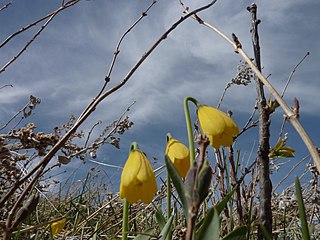
Fritillaria pudica, the yellow fritillary, is a small perennial plant found in the sagebrush country in the western United States and Canada. It is a member of the lily family Liliaceae. Another common name is "yellow bells", since it has a bell-shaped yellow flower. It may be found in dryish, loose soil; it is amongst the first plants to flower after the snow melts, but the flower does not last very long; as the petals age, they turn a brick-red colour and begin to curl outward. The flowers grow singly or in pairs on the stems, and the floral parts grow in multiples of threes. The species produces a small bulb, which forms bulblets earning the genus the nickname 'riceroot'. During his historic journey, Meriwether Lewis collected a specimen while passing through Idaho in 1806.
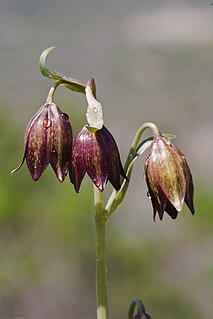
Fritillaria biflora, the chocolate lily or mission bells, is a species of fritillary native to western California, US, and northern Baja California, Mexico. It occurs in the chaparral and woodlands ecoregion, often in serpentine soil formations and hillside grassland habitats.
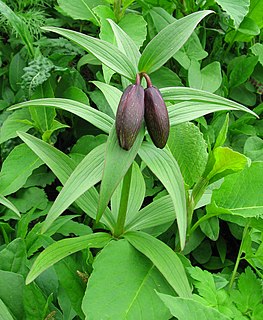
Fritillaria camschatcensis is a species of fritillary native to northeastern Asia and northwestern North America, including northern Oregon, Washington, British Columbia, Alaska, northern Japan, and the Russian Far East. It has many common names, including Kamchatka fritillary and Kamchatka lily.

Fritillaria uva-vulpis is a bulbous perennial plant belonging to the genus Fritillaria and native to eastern Turkey, north-western Iraq and western Iran. They are mainly found in the wooded foothills of the Zagros, where they grow in damp meadows and cornfields between 900 and 1800 m above sea level.

Fritillaria gentneri, or Gentner's fritillary, is a rare species of flowering plant in the lily family Liliaceae, that is endemic to southwest Oregon and adjacent Siskiyou County, California, USA. Its habitat is dry, open woodlands and chaparral at 1,000–5,000 ft (300–1,520 m), where it blooms from March through July. However, most populations have generally finished blooming by the end of May. As with many plants, the lower elevations bloom earliest with the bloom period moving up following elevation.
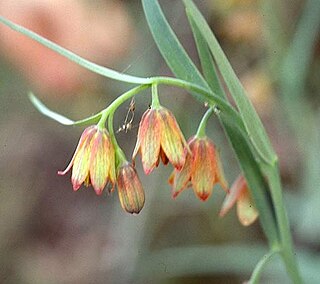
Fritillaria eastwoodiae, also known as Butte County fritillary or Eastwood's fritillary is a rare member of the Lily family (Liliaceae), native to the foothills of the northern Sierra Nevada, and Cascade Mountains in California and southern Oregon, USA.

Fritillaria glauca is a species of fritillary known by the common names Siskiyou fritillary and Siskiyou missionbells.
Fritillaria micrantha, the brown fritillary or brown bells, is a Californian species of flowering plant in the lily family Liliaceae.

Fritillaria ojaiensis is a rare species of fritillary known by the common name Ojai fritillary.

Fritillaria pinetorum, the pinewoods fritillary or Davidson's fritillary, is an uncommon species of fritillary.

Fritillaria striata, the striped adobe lily, is an uncommon species of fritillary.

Grayia is a genus of plants in the subfamily Chenopodioideae of the family Amaranthaceae. Common names are siltbush and hopsage. The four shrubby species occur in arid and semiarid regions of western North America:

Salvia brandegeei is a perennial evergreen shrub in the mint family known by the common names Santa Rosa Island sage or Brandegee's sage. It is a fragrant plant characterized by lavender flowers and dark green leaves. For many years, it was thought to be native only to Santa Rosa Island, one of the Channel Islands of California, until it was discovered along the coast of Baja California. It is threatened by development and mining along the mainland portions of its range, but otherwise has a stable population on Santa Rosa Island.

Fritillaria purdyi, the Purdy's fritillary, is a rare species of flowering plant in the lily family Liliaceae.
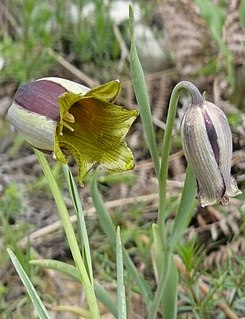
Fritillaria acmopetala, the pointed-petal fritillary, is a species of flowering plant in the lily family Liliaceae, native to rocky limestone mountain slopes in the Middle East. It was described by the Swiss botanist Pierre Edmond Boissier in 1846.
Calochortus westonii, common name Shirley Meadow star-tulip, is a rare endemic plant known only from the Greenhorn Mountains range of the southern Sierra Nevada, within Kern and Tulare Counties, California.

Fritillaria biflora var. ineziana, the Hillsborough chocolate lily, is a species of fritillary endemic to San Mateo County, California. It grows on serpentinite in cismontane woodland and valley and foothill grassland at elevations that range from 295 to 525 feet It is typically found on serpentine soils and it is defined as a "broad endemic" where 85-94% of occurrences are expected to occur on ultramafic soils.

Fritillari japonica is a perennial herbaceous bulbous plant, endemic to Japan. It is a species in the genus Fritillaria, in the family Liliaceae. It is placed in the subgenus Japonica.


















